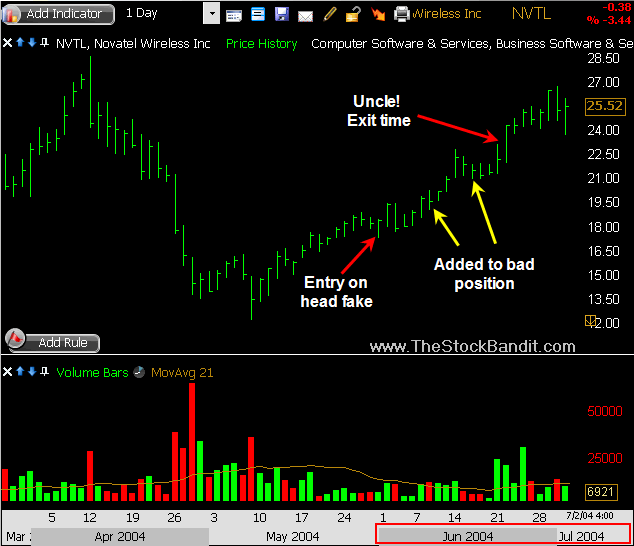 All Entries in the "Trading Psychology" Category
All Entries in the "Trading Psychology" Category
Always Something to Worry About
November 11, 2009 at 12:12 pm
Ever get spooked out of good trades? It’s one of the worst feelings in trading, knowing you were right and just couldn’t stick with the play long enough to get paid a fair amount.
The back-and-forth nature of the market makes it easy to jump to conclusions that a turn may be right around the corner, perhaps even a painful one. As a result, it can be really difficult to stay in good trades, or to continue riding a trend which has gotten a little bit long in the tooth. The flight to safety plagues us all from time to time – often prematurely.
An example is the current environment. The indexes have made a tremendous move up from the March lows, making it hard for those with inventory to stay long or for those with cash on hand to put it to work after such a surge. What if the trend changes?
Or take that trade you were in last week. You nailed it – well, the entry at least. Sure would be nice if you were still in there, huh?
Well, I’ve been there. I’m familiar with that frustrating feeling. And you know what I’ve come to realize?
There’s always something to worry about in the stock market.
Earnings, upgrades/downgrades, the Fed, interest rates and inflation, terrorism, nukes, the economy, elections, geopolitical events, strained relations with other countries, etc. It’s virtually an endless list. Looking back over my past 11 years in the market, I can recall “major” concerns for every calendar year. And yet for every single year, there were some phenomenal stretches of trading.
There’s literally always something going on. That something may be a driver of prices, or it may simply be a sideshow – a distraction, if you will.
But here’s the thing… for traders like you and me, what matters is how we respond to the conditions – not what the actual conditions are or our ability to determine what’s going to happen next. We have to walk that fine line between making wise decisions to protect our capital and allowing some fluctuations to occur so we remain on the right side of the tape and fatten our accounts.
Profits come from putting money at risk when there’s some potential payoff. For individual traders like you & me, it means we need to be agile enough to hop on board with whatever it is the big money is doing. Doesn’t matter why they’re doing it. It only matters that we pay close enough attention to determine the trend and find appropriate spots to take action. We get paid for taking risks – especially the right kind.
Silence is Golden
Don’t be surprised if you can at any point in time find arguments for why the next bear market is about to begin, or why prices will never decline again. Not only is there a constant difference of opinion, but there often is some decent logic behind those arguments, whether bullish or bearish. That’s what makes a market – thank goodness!
But those opinions will be shrugged off many times, so our flexibility is critical.
Bears and bulls alike will constantly beat their drums as to why they’re positioned the way they are. Don’t let that be the reason you put cash to work or pull cash out of good trades. Get long during uptrends, and get short during downtrends and you’ll come out just fine. It isn’t necessarily ‘easy’ but it is simple.
Stick to the charts and keep ‘reasoning’ in check, because the market can defy logic for extended periods of time. Is it doing that right now? Who cares! Prices will do what they do, and it’s our job as traders not to predict anything – but to react accordingly. Trade what you see – not what you think – and you’ll usually be far better off.
Thanks for stopping by and I’ll see you here soon with more.
Until then… Trade Like a Bandit!
Jeff White
Are you following me on Twitter yet?
The Power of Focus
September 21, 2009 at 9:23 am
Just last weekend, Tiger Woods collected another trophy. It was an impressive win by a wide margin, his 10th career win by 8 shots or more. And while he’s posted 6 wins this year alone, there’s one in particular I’d like to discuss today. Surprisingly, examining it offers some real value for us as traders.
On July 5th, Tiger held a 1 stroke lead heading into the 72nd hole of the tournament he hosts, the AT&T National. Needing only a par to win, he rifled a 3-wood down the fairway. Holding a 9 iron as he stepped to hit his approach shot, his focus was as intense as it had been all day. He chose a specific target, mentally rehearsed the shot, and executed it perfectly with a shot to about 12 feet. Enough for an easy 2-putt for the win.
The highlight reels didn’t mention how he played the 18th, and some would say it was downright boring and uneventful compared to other shots he hit that day. However, his focus did not waver with that all-important par at the last. He was ready for it, and he added yet another victory to his resume because of it.
So how does all this relate to trading?
Well, for each of us who have ever faced our screens with fear or trepidation, the study of a great performance by a top athlete will always offer applicable lessons. Observing someone else who’s producing great results under pressure gives us an opportunity to grow and improve, so it’s always an exercise worth doing.
Let’s learn a few things from Tiger…
Preparation = Confidence
When it’s time to get ready to play, nobody outworks Tiger. He’s willing to put in the necessary time to get the results he wants. Are you? When it comes to your trading, if you were to rate your level of effort with regards to preparation, how would you fare? The very best traders aren’t lazy. They thoroughly prepare for a variety of scenarios, and it enables them to respond in the heat of the moment with confidence. If you’re not confident, you’re probably not preparing adequately.
Confidence = Chances to Win
We’ve all heard the phrase ‘confidence breeds confidence.’ It’s true. Showing up with a winning mindset is at least half the battle, whether it’s sports or trading. It’s a positive outlook rooted in the fact that you’re ready for whatever comes your way. You’re patient yet aggressive, and you know that you won’t fall prey to hesitation or indecision. That mental sharpness elevates your performance, and it increases the chances that you’ll be at your best. As a result, winning becomes more likely.
Frequent Chances to Win = Success
Giving yourself the best chance to perform well day in and day out will repeatedly open the door for success to happen. It’s aided by good preparation and a thorough routine, and it results in better focus and even a more relaxed state when it’s all on the line. What each of us want is to have opportunities to create big performance breakthroughs regularly, because we know we’ll capitalize on some of those. Tiger wants to have a chance to win going into the back 9 on Sunday, to him that’s what it’s all about. Prepare in such a way that your odds for success naturally increase. Anticipate multiple scenarios, visualize how you’ll respond, and set fear aside as opportunities come your way. The confidence you’ll derive from that will go a very long way toward helping you convert a decent day or month into one you’re really proud of.
Whenever you have the opportunity to observe the best when they’re at work, do it. Regardless of the endeavor, you’ll see the power of focus at work and pull some qualities from that experience to apply to your trading.
Thanks for stopping by and I’ll see you here soon with more. Until then…
Trade Like a Bandit!
Jeff White
Are you following me on Twitter yet?
More on Recovering from Trading Losses
August 17, 2009 at 6:44 am
Ever been downright frustrated with your trading?
If you’ve been a trader for any length of time, I’m sure you have. There can be stretches of disappointments during which it feels like getting on the right side of a move might not ever again happen. Your account shrinks and your confidence takes hit after hit, causing you to question your desire to continue playing the game.
If it sounds like I’ve been there, it’s because I have been. Multiple times. Every time I’ve hated it just as much as the first time, but every time I’ve emerged as a better trader. No pain, no gain!
Dealing With Drawdowns
I think it’s a good exercise for every trader to know their thresholds, and to determine just what you’re willing to lose during a poor trading stretch. That’s not to say you plan on it, but rather you designate some amounts, which if lost, will prompt you to make some immediate adjustments.
That might be a dollar amount subtracted from your account highs, or it might be how many consecutive losing trades you’ll endure when a drawdown occurs. Once those flags have been raised, it’s time to shift the routine.
It doesn’t mean you entirely abandon an approach which has proven to work for you over time, but rather that you install some safety rails for yourself before the damage becomes far more difficult to repair.
Short-Term Steps for Long-Term Survival
If you’ve suffered from a recent drawdown, it’s important that you take a few steps to get back on track – both in the near term and for the long haul.
In the near term, it’s crucial to preserve whatever confidence you have left. Remember, that’s your psychological capital, and it must be protected. Take a few days away from trading, maybe a week, and just clear your head. This may sound obvious, but stepping away is the best way to stop losing! Discouragement leads to some poor decisions in trading, so come back in a few days to resume trading after some of the irritation has subsided.
When you do begin again, cut your position size down to an amount which is insignificant, whether win or lose. You want to gain some confidence in trading well once again, making some good choices without the influence of recent losses. P&L becomes an afterthought at this stage.
Focus on the method, on making good trades which work, and then gradually increase your trade size so that the profits return. The first few trades might not grow your account, but they can greatly aid your thinking process by lifting the pressure of “making it back” and then you can get to that shortly thereafter.
Staying in the Game
A string of losing trades is no fun – downright frustrating, irritating, and bothersome. But the idea is to limit the losses when they do come (and we know they’ll come, that’s just part of trading) so that we are still trading when the best opportunities come along.
That’s how my method is. I equate it to a poker player who loses small, hand after hand, folding to surrender antes before finally sticking with his bet when a good hand comes along so that he can win a pot. Lose small, lose small, win big – that’s exactly how trading must be. How you choose to respond to losing will make or break you.
Thanks for stopping by and I’ll see you here soon with more. Until then…
Trade Like a Bandit!
Jeff White
Are you following me on Twitter yet?
Scale Out of Winning Trades with Partial Exits
August 4, 2009 at 12:55 pm
It’s common among traders to think that you either have to be all-in with a stock or all-out of a stock, but that sure isn’t the case.
Many of us do our buying in one piece, entering a full position at one time as an important level gets crossed. This is my personal preference, as I continually seek out trading opportunities where a ceiling is shattered or a floor implodes, enabling price to make a nice move through it.
And when I am wrong (yes, when, not if ), I’ll exit in one piece. As events occur or conditions emerge to show me that the stock is clearly moving in the opposite direction of what I had expected, I’m going to bail out of the trade and protect capital.
So, I’m getting into trades in one piece, and I’ll stop out of trades in one piece. But rarely will I exit a winning trade in just one piece. Instead, I’ll scale out.
Advantages of Incremental Profit-Taking
Over the years in dealing with traders from literally around the globe, I’ve found that very few of them will get out of favorable trades in pieces. Adopting this method of booking profits can be an excellent way to trade, and particularly in a momentum-based market like the one we currently find ourselves in.
Taking partial profits and peeling off a portion of your position on the way up carries with it several advantages. Let’s look at a few…
1. You can lighten your exposure into favorable moves. As your trade makes its move, it’s a great idea to start reducing your position size. The idea is that as a move progresses, it naturally becomes more difficult to capture similar returns to the initial move. Typically stocks surge early, so this is a way to take advantage of that early momentum.
2. Make room for new opportunities. This isn’t just for those who may be trading with a smaller account and need to raise cash to put toward a new play. In fact, even traders with larger accounts may find it difficult to manage a lot of positions in terms of the attention they can devote to each trade. Catching the move you initially were seeking can remind you that it may be time to shed some shares and seek out another stock to put your money and/or attention into.
3. Let slippage work in your favor. Posting offers on the way up means you’re capturing the bid/ask spread – not paying it. I use market orders for entries and for stopping out, because when I need to be in or out of a trade I don’t want to haggle over a few cents. But when it comes to booking profits, limit orders resting at higher levels mean you’re out there offering out some inventory, letting someone else pay up for it.
4. Satisfy the urge to take cash off the table, yet still stand to gain from a continued move. This is a big confidence booster as well as a way to manage money wisely. Turning some of those paper gains into real profits not only pads your account, but it also reinforces that you’re on the right track. Gaining some momentum in your trading is a great thing, both for your account and for your psyche. And by adjusting the stop for remaining shares, keeping even a portion or a core position allows you to benefit from a major move, should it occur.
Trade Like a Surfer
Just as a surfer catches one wave after another, a good trader maintains the same mentality. Ride the best moves you can find, but don’t be shy about easing out of a trade once you’ve caught a nice move. Paddling back out to locate the next one will require your availability, so when you start smiling about a trade, it’s probably time to start scaling out.
The fear of missing out on a giant run keeps many traders from selling at all, but scaling out carries with it the best of both worlds.
Consider making partial sales in your next winning trade, and see what it does for your bottom line. It just might be the best adjustment you make this year.
Thanks for stopping by and I’ll see you here soon with more. Until then…
Trade Like a Bandit!
Jeff White
Are you following me on Twitter yet?
Halftime Honesty
July 1, 2009 at 8:23 am
 The year is halfway over, and I hope you’re exceeding your expectations for 2009 thus far.
The year is halfway over, and I hope you’re exceeding your expectations for 2009 thus far.
With an extended holiday weekend approaching, it’s the perfect time to pause and reflect on not only your performance, but also your process.
So let’s head to the proverbial locker room and examine how the first half has played out. Doing so will enable us to properly prepare for the 2nd half and finish strong the way every winner should.
First 6: Something for Everyone
2009 has been an interesting year already. January began with some real promise as the market sprinted higher for a whopping 3 days before turning south and stomping on the gas. We headed lower into mid-March, when a meaningful upside reversal brought about significant gains – and virtually in a straight line for some 9 weeks before pausing. Since then, we’ve climbed incrementally higher, and currently stand somewhat range-bound with traders waiting for momentum to return.
That means that to date, we’ve had several kinds of price action with the market throwing the kitchen sink at traders. Downtrends, reversals, rip-roaring rallies, and even a few trading ranges have been seen.
The way I see it, that’s a little something for everyone. Including you. So if I were to ask you how you’d grade your performance during your favorite stretch, what would you say?
And more importantly, where do you see room for improvement?
Right now’s the time when brutal honesty can bring big benefits – if you’re brave enough to bear it. Sure it’s more fun to reminisce about the best trades we’ve made, but the failed trades and the missed opportunities hold within them perhaps the greatest promise – the chance to learn and apply, and with it, the chance to rise above our previous best.
I don’t know about you, but that fires me up.
I’m always looking to gain an edge, and I love working toward continual improvement. Growth and sharpened skills do much more than pay the bills – they motivate and reward me. The thought of getting better gives me some momentum, particularly in my mindset. Trading is such a mind game that having an edge there means more to the bottom line – which is nice, because I do not like to lose.
New Year’s is Coming
Here in Texas right now, we’re seeing triple digit temps daily and it’s quickly becoming the Great Yard Bake of 2009 with the heat wave we’re in. Summer is in full swing, but you know what? Winter will come.
When you stop to think about December 31st, it probably seems forever away. But put yourself there mentally for a moment, and think about how you want your 2009 to finish.
Will the halftime checkup prove to be a turning point for you, or will you have squandered an opportunity to grow in the 2nd half?
My hope is that the former will be true for you. Right now, you might be fed up with the current trading ranges and lack of momentum. You might hate the summer doldrums and just want a break from it all. And truthfully, now’s not a bad time for that if so (I just spent 10 days in the Caribbean).
But if you’re driven to grow and improve and make this the year you actually make some real strides – both in your account and in your mindset, then right now is the perfect opportunity to pause and pay attention to your process.
Spend some time crunching the numbers. Put in a few hours to review – truly review – your trades from the first half, and be honest and see what you learn. Some of them you nailed…congrats! But others you knew you should have taken and didn’t. Find out why. Some of them you bailed out of too quickly, micromanaging them by undermining your original plan. Figure out what happened. And yes, a few of them you got blindsided by. It happens, but really do your best to determine whether the fault was your own and something you can avoid in the future.
The Moment of Truth
Here’s the thing… the future arrives daily, and either you’re prepared for it or you aren’t. Either you want success bad enough to find it, or you’re satisfied enough with mediocrity to keep enduring it.
Get honest with yourself, and before you head out for the 2nd half, decide how you want to feel the next time you walk off the field. The first half is over, and only you can determine what happens in the 2nd half. Get clear on what you want.
I want to win.
Trade Like a Bandit!
Jeff White
President, The Stock Bandit, Inc.
Swing Trading & Day Trading Service
www.TheStockBandit.com
[tags]Stock Market, Day Trading, Stock Trading, Investing, Swing Trading[/tags]
Lessons from My Biggest Trading Loss
May 28, 2009 at 9:58 am
 The trading has been really, really good lately. I’ve been fortunate to nail some nice moves for both day trading and swing trading timeframes, which of course is always fun.
The trading has been really, really good lately. I’ve been fortunate to nail some nice moves for both day trading and swing trading timeframes, which of course is always fun.
But in order to recognize and appreciate the good times, one must also go through some periods of poor performance. You have to struggle, and fight through the pain. Expensive lessons get learned, and thank goodness, they can stay with you for a while.
That’s what I’m here to tell you about in this post.
I want to show you some lessons I learned from the biggest trading loss I ever took, and hopefully you’ll benefit from my mistakes. After all, standing on someone else’s shoulders is the best way to look forward.
Setting the Scene
With summertime having arrived in 2004, the usual conditions were present. That means lighter trading volume – and whenever that’s the case, I tend to prefer short selling over buying. (I view volume as the fuel needed to propel a stock higher, so when it’s present, I realize bidders can simply disappear and the stock can slide without needing high activity.)
Having noticed a deep correction in NVTL which shaved off about 1/2 its value in just a few weeks, I had the stock on the radar and was waiting for a good setup. No harm so far.
It had begun a lazy, light-volume bounce off its correction low, which of course left me skeptical. I watched for the pace of the bounce to slow, and once it did, I started a position. That was on June 1 as it attemped to roll over slightly, but it was merely an attempt.
The following day, NVTL made a new recovery high, but I stayed in the position. Mistake #1. As soon as the bounce resumed, that was grounds for dismissal, but I stuck around in a stubborn fashion. A week later, NVTL was again on the move, and I found my P&L turning deeper red by the day.
I was wrong, and it hurt. So I did what any trader in the midst of breaking trading rules would do – I added to my position. Mistake #2. Now I’m in a bad trade and I have too much of it. Why? Because I needed to be right. Mistake #3.

StockFinder Chart courtesy of Worden
Long story short, after adding a couple of times on the way up to improve my basis, I ultimately drew a line in the sand which was crossed 3 weeks after my entry. I blew out of the trade… stunned, bruised, and yet relieved.
Ultimately NVTL corrected, but I would have had to hold the position for another month and endure another 10% against me before that happened. Even then, I only would have been able to exit at breakeven.
It was a nasty loss, and it angered me to have allowed it. Now 5 years later, I still shake my head at the series of mistakes I made, but it’s a great reminder to me of what can happen when I allow myself to break my rules.
Reminders & Takeaways
- “Paper” losses are very real. Many try to fool themselves into thinking that because a gain or loss hasn’t been realized, that it should be viewed differently. Wrong. If you’re underwater in a position, you’re losing whether it’s a closed or open position.
- Adding to losing trades is a recipe for pain. If you’re already in the hole and you’re already in the size of position you originally intended to be in, you stand to dig a deeper hole and cloud your judgment even more. Don’t add to a losing position when it’s a hail-mary effort at escaping a bad trade.
- Accepting a big loss can bring about some needed relief. For one, you’re ending the loss – it can get no worse. That’s a big reduction of stress and distractions from your other trading efforts, which is a huge benefit. You’re also accepting that you were wrong, and creating some closure which mentally helps you move on. There’s no substitute for a clear head when trading, so take it. Further, there are few things worse than logging into your trading platform and staring at a giant loser day after day.
- Being early = being wrong. This trade ultimately moved back in the direction I thought it would, but not until it had far exceeded my “uncle” point. Just goes to show that the market can continue moving against you for longer than you can handle it sometimes, so it’s never worth arguing with.
If I could get away with only talking about my great trades here, it might be more enjoyable for me, but you’d take less away from it as a reader.
And the reality is that I lose on plenty of trades. But there is much to be gleaned from glancing in that rearview mirror, both for me and for you. That’s how we get better!
Sometimes it comes with a grin and sometimes with a grimace, but it always offers valuable lessons to gain from. I hope you’re willing to do the same with your own trades.
Are you watching the Trading Videos over at TheStockBandit.TV?
Jeff White
President, The Stock Bandit, Inc.
Swing Trading & Day Trading Service
www.TheStockBandit.com
[tags]Stock Market, Day Trading, Stock Trading, Investing, Swing Trading[/tags]
Excuses are a Waste
May 5, 2009 at 11:04 am
As the producer of a stock newsletter for the past 5 years (wow, time is flying), I get a lot of email.
Some of it is from subscribers, and some of it is from people who are ‘tire kickers’ and haven’t decided yet to take control of their trading. They want to know if what we offer can get them to the next level.
A response is always provided to them of course, but it’s not always what they want to hear. The deciding factor is their attitude.
You see, in their emails they often times want to air out some garbage and tell me a story. It goes along the lines of “I used to be good at this, then I hit a rough patch and now I’m lousy. Can you fix me?”
And although their ‘story’ might be factual, that rough patch probably isn’t what’s holding them back. It’s their reliance on it. They lean on it like a crutch, because it gives them an identity, a safety net to fail into – for now. They have to stop relying on that and get back on track.

There will always be people like that, and neither I nor anyone else can bring about a change in them – they have to do it for themselves. They have to move beyond that mindset and toward something they really want.
The “I’m losing and it isn’t my fault” attitude is an excuse, and it’s not going to get you anywhere. A lack of success can’t be blamed on circumstances.
I know because I’ve had that attitude.
A few months ago, I was putting together an educational course for people who want to learn trading. It was a big project and it brought about some demands on my time which previously weren’t there. What used to be free time was replaced for a little while with work on that project, and so my situation was temporarily different.
Out of my routine, I fell into a trading funk for a few weeks. I was wrong a lot and irritated regularly with my trading. And I told myself it was because of that project. When asked by friends how my trading was going, I’d say “it’s been better, but I’ve been really busy with the educational course” – as if anyone cared. As if that project were the reason why I was struggling with my trading.
Nonsense.
Once I stopped relying on that excuse and decided to get a grip – and it is a decision – I was finally free to get back to the winning ways I had been missing. I wasn’t being driven by every little tick which might have gone against me, and I wasn’t as afraid that open profits might quickly disappear. As a result, my trading improved rapidly.
But it all began with my attitude.
So here’s the thing… If you’ve got loser’s limp and you find you’re frequently making excuses for your trading results, consider this a wake-up call.
That attitude is leaving you stationary like a turtle in mud (no, not that kind of Turtle), and you’re going nowhere fast. Get back on track mentally and move toward the attitude you know you should have.
The past is there to serve you, not hinder you, so take what you can from it and move forward. Once you’re thinking better, I’ll bet you start trading better too.
Jeff White
President, The Stock Bandit, Inc.
Swing Trading & Day Trading Service
www.TheStockBandit.com
[tags]Stock Market, Day Trading, Stock Trading, Investing, Swing Trading[/tags]






